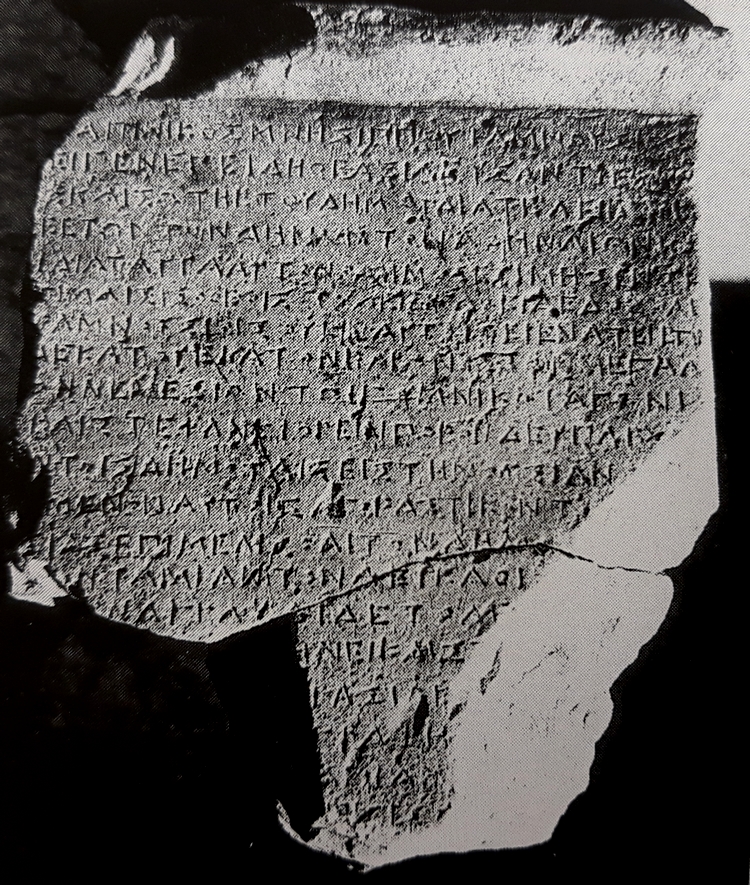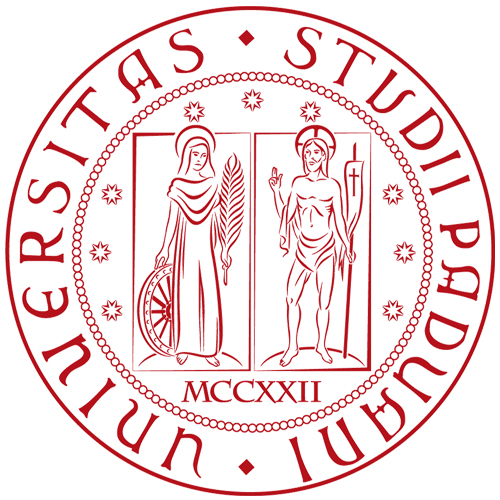
PHRC063 : Decree of the deme of Rhamnous honouring Antigonos II Gonatas - Attica (c. 255 BC) Decree
Permanent ID: http://s.phrc.it/phrc063.2
Images
Photo 1: Photo of the stone, from I.Rhamnous 7

Text constituted from: I.Rhamnous 7.
Other editions: ed. pr. Petrakos 1989 (1992), 31-34, no. 15 (=SEG XLI 75); P. Gauthier, BE (1994), no. 299 (=SEG XLII 115) on lines 16-17 (followed in I.Rhamnous 7).
See also: on the date of the decree c. 255 BC, see Gaughier in BE (1994) and Habicht 1996, p. 131-134. Contra, but less convincingly, Kralli 2003 proposes the mid-240s and points to the conflict opposing Gonatas to his nephew Alexander (overview of the debate in Haake 2011, 111). For a general discussion of the text, see Kotsidu 2000, 103-104, cat. 50 [E]; Haake 2011; Oetjen 2014, 182-183, no. 7; Habicht 2017, p. 194-195. On the career of Elpinikos, see Paschidis 2008, 183-185. An introductory overview of the topography of Rhamnous is provided by Petrakos 1991, with refs. On the local cult of Nemesis, see also Haake 2011, 112-116.
Images: Petrakos 1989 (1992).
Further bibliography: On isotheoi timai, see Chaniotis 2007; Iossif 2014, 130; Caneva 2023 (forthcoming). On cultic honours for Antigonos II, see Habicht 1996; Haake 2011; Landucci 2016; Mari 2021. On the relationship between Antigonos and the Greek cities, see now Waterfield 2021.
[Ἐ]λπίνικος
Μνησίππου
Ῥαμνούσιος
εἶπεν· ἐπειδὴ
ὁ βασιλεὺς
Ἀντίγονο
-
ς καὶ σωτὴρ
τοῦ δήμου,
διατελεῖ εὐερ
-
<γ>ετῶν
τὸν δῆμον
τὸν Ἀθηναίων κ[α]
-
5
ὶ διὰ ταῦτα αὐτὸν
ὁ δῆμος
ἐτίμησεν {τι}
τιμαῖς
ἰσοθέοις,
τύχει ἀγαθεῖ·
δεδόχθαι
[Ῥ]αμνουσίοις
θύειν
αὐτῶι
τεῖ ἐνάτει ἐπὶ
δέκα τοῦ Ἑκατονβαιῶνος,
τῶν μεγάλ
-
ων Νεμεσίων
τῶι γυμνικῶι ἀγῶνι
10
καὶ στεφανηφορεῖν,
πόρον δὲ
ὑπάρχ[ε]
-
[ιν] τοῖς δημόταις
εἰς τὴν θυσίαν
τ[ὸ γε]
[νό]μενον
αὐτοῖς ἀγοραστικόν·
τ[ῆς θυ]
-
σίας ἐπιμελῖσθαι
τὸν δήμ[αρχον κ]
-
[αὶ τὸ]ν ταμίαν τὸν
ἀεὶ
καθι[στάμε]
-
15
[νον]·
[ἀ]ναγράψαι δὲ
τόδε [τὸ ψήφισμα]
[ἐν στήλει λιθ]ίνει
καὶ στ[ῆσαι παρὰ]
[τὸν βωμὸν τοῦ]
<βα>σιλέ[ως Ἀντιγόνου]
[..?..]ΙΛΙΗ[..?..]
[..?..]ΜΓΙΑΡ[..?..]
20
[..?..]ΣΙΣΙΣ[..?..]
[..?..]
This decree was passed by the deme of Rhamnous in honour of Antigonos II sometime between the end of the Chremonidean war and the death of the king (262/1-240). As convincingly proposed by Gauthier and Habicht, this time range can be significantly reduced as the most plausible event that may have caused the granting of honours is Antigonos’ concession of freedom to Athens in 256/5 BC (contra, Kralli 2003, less convincingly suggesting a link with an episode of the conflict between Antigonos and his nephew Alexander in the mid-240s). At this date, the king reportedly withdrew the garrison imposed on the city after the end of the Chremonidean war and also returned various Attic fortresses to the direct control of the Athenians (Paus. 3.6.6, Eusebios Chron. 2.120; Habicht 2006, 171). That the city bestowed cultic honours upon the king out of gratitude for this concession can be evinced from lines 16-17 of the Rhamnous decree, which mention the existence of an altar of Antigonos. Since the erection of this altar is not the topic of Elpinikos’ proposal, it is possible that it had been previously built up in Rhamnous (and possibly in other demes) as the consequence of a civic decree (cf. Paschidis 2008, 184).
There are at least three reasons that make this decree a particularly important entry in the PHRC collection. The first is that this document has forced scholars to reassess the idealised image of Antigonos II provided by ancient authors. According to this vision, Antigonos II operated as a philosopher king who rejected the image of charismatic kingship promoted by his father Demetrios Poliorkets and took the distance from the contemporaneous practice of cults for sovereigns. This decree instead reveals that Antigonos II received and, as all other Hellenistic kings, did not reject cultic honours from his subjects (Habicht 1996; Landucci 2016; Mari 2021). Secondly, the Rhamnous decree refers to the cultic honours granted to Antigonos by the city of Athens with the remarkable formula isotheoi timai. Although usually taken by modern scholars as the most common way by which the Greeks referred to cultic honours for Hellenistic leaders, this expression is in fact extremely rare in the 3rd cent., when the only other epigraphic occurrence comes from the so-called “Nikouria decree” issued by the Nesiotic League to honour Ptolemy II and his deceased father Ptolemy I (c. 280 BC; IG XII 7, 506; further discussion on the use of this formula in Caneva, forthcoming). Thirdly, the text from Rhamnous shows that an administrative partition of a Greek polis (a deme, a tribe, etc.) could not only implement the civic honours granted to a political leader, but also build upon them to charge them with local significance and embed them within the religious life of the community (for a comparison with similar cases, see commentary to PHRC 044, a decree passed by a tribe of Iasos). More precisely, the existence of a demotic sacrifice addressed to Antigonos is in contrast with the observation by Mikalson that offerings directly addressed to Antigonid rulers were progressively replaced during the 3rd cent. by others made to gods for the wellbeing of (hyper) the kings. As a matter of fact, all the preserved documents concerning ritual honours for Antigonos II or Demetrios II involve the hyper formula. Apart from our decree from Rhamnous, the only attestation of a sacrifice directly addressed to Antigonid recipients in 3rd-cent. Athens might concern the dynastic founders Antigonos I and Demetrios Poliorketes, if indeed these persons are to be identified with the Soteres mentioned in a decree dated 233 BC ( Agora XV 115; for an overview of the evidence, see Mikalson 1998, 160-161; Paschidis 2008, 521-523). We may assume that a more direct form of religious honours for the king was established in Rhamnous because of the importance that a direct Athenian control over the important local fortress had for the life of the deme. Moreover, one should not neglect the possibility that both the sacrifice and the denomination “Soter of the Demos” were intended to establish a direct link between Antigonos II and his ancestors.
In addition to the honours approved by the city, the deme of Rhamnous introduced other cultic activities meant to thank Antigonos. A sacrifice to the king is established on 19 Hekatombaion (possibly the day of his birthday: Paschidis 2008, 183). On this occasion, the citizens of Rhamnous would participate in the event wearing garlands, a typical feature of Greek festivals, including those for political leaders. The event had a definite local meaning as it was associated with the most important festival of the deme, the Great Nemesia. The sanctuary of Nemesis was the principal sacred place in Rhamnous (Petrakos 1991; Haake 2011). By adding a festival for the birth of Gonatas to the one honouring the goddess of righteous vengeance, the deme institutions may have wished to celebrate the memory of Antigonos’ victory in the Chremonidean war (and possibly to evoke the Celtic victory of Lysimachia, thanks to which he had come to the throne: see Haake 2011). Unfortunately, the loss of the last part of the decree makes it impossible to locate the altar of Antigonos, which plausibly hosted the sacrifice to the king, and next to which the stele containing the decree was to be published. However, given the link between the sacrifice and the Nemesia, it is tempting to propose that the altar stood within the sanctuary of Nemesis.
The decree also informs us about the administration of the cult: the funds used to finance the festival were taken from the agorastikon, probably a demotic tax on transactions at the local market and port (Whitehead 1986, 150-152). This sum was administered by the demarch and the treasurer. On the other hand, we have no indication about who would actually accomplish the sacrifice. In this regard, the reference to the “demotai” may simply identify the deme as a collective agent, in which case we may assume that the sacrifice was accomplished by a magistrate or by a priest of the deme. However, this term could also suggest that the sacrifice was performed by a plurality of agents who received the sacrificial animals from the demarch. In this case, the demarch would probably have the task of purchasing the animals with the money allocated by the treasurer and then of providing them to the citizens for their sacrifice on the altar of Antigonos (for a similar funding method, see IvP I 246, a decree of Pergamon for Attalos III; lines 39-42 state that each phylarch was in charge of providing the citizen of his tribe with the animals bought with the public money allocated for the event; cf. Caneva 2020b, 154-155).
After 256/5, Antigonos II and Demetrios II continued exerting their influence over the political life of Athens (Habicht 2006, 169-184; Paschidis 2008, 513-521), but direct control was replaced by diplomacy driven by the Athenian pro-Antigonid party. In this context, ritual honours provided the city with an effective means to express loyalty and to negotiate autonomy and privileges with the Macedonian crown. Thus, another decree proposed by Elpinikos in 236/5 BC proves that the sacrifice to Antigonos II at the Nemesia was still practised during the reign of his successor, Demetrios II ( I.Rhamnous 17, lines 27-30). However, Antigonos’ honours did not survive the political turn of 229, when, after the death of Demetrios, Athens abandoned the Macedonian alliance in favour of a new collaboration with Ptolemy III. This change of geopolitical orientation was soon reflected by the establishment of a series of cultic honours for Ptolemy III and Berenike II, including the Ptolemaia festival attested in the evidence from Athens and from the fortress at Rhamnous (the Ptolemaia were established in 224/3; see Habicht 2006, 199-204, 456-457). Remarkably, the evidence concerning the Nemesia at Rhamnous does not mention the sacrifice to the king from 225/4 BC onward (Habicht 1996, 133; Haake 2011, 121). At the end of the century, the rasura of Antigonid royal names from a large number of Athenian decrees (including the above-mentioned I.Rhamnous 17, line 6) reminds us that no ritual honours of any Antigonid king survived at all after the damnatio memoriae of the dynasty decreed in Athens in 201/0, at the beginning of the war between Philip V and Rome ( Livy 31.44.2).



